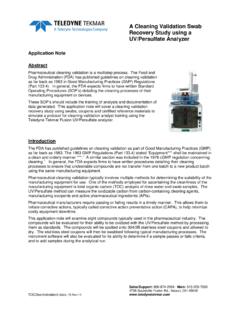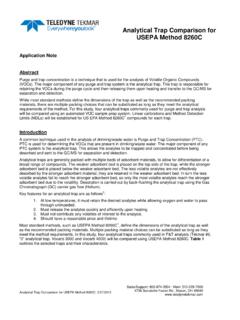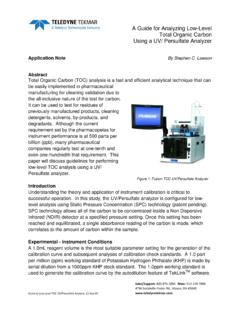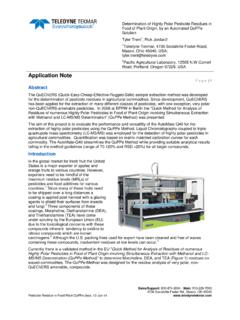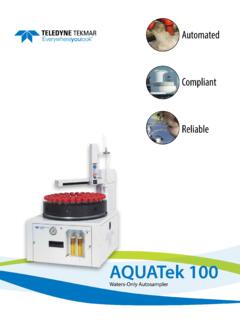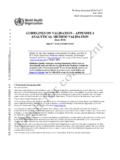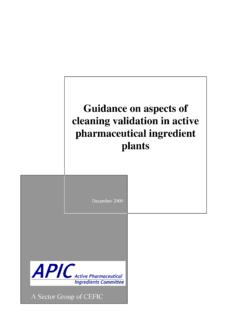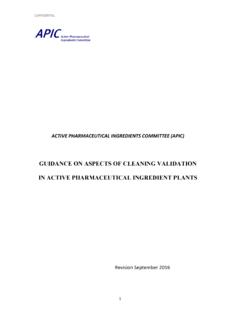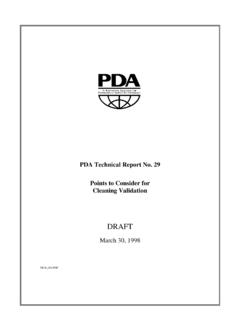Transcription of Analysis of Cleaning Validation Compounds using …
1 Analysis of Cleaning Validation Compounds using the TOC Fusion Analyzer 4736 Socialville Foster Rd Mason, OH 45040 Page 1 of 4 ABSTRACT By taking an active approach to prevent cross-contamination in pharmaceutical and cosmetic production, international agencies such as the USFDA, ICH, EC, Health Canada, and the WHO have established regulations and guidelines for effective Cleaning and With the potential side effects due to exposure, limiting carry-over of residual Compounds into subsequent batches is crucial. Equipment and utensils shall be cleaned, maintained, and sanitized at appropriate intervals to prevent malfunctions or contamination that would alter the safety, identity, strength, quality, or purity of the drug product beyond the official or other established requirements.
2 7 Production equipment should be thoroughly cleaned on a scheduled basis. 8 This study focuses on the Analysis of Cleaning Validation samples using TOC without carryover concerns, negative impacts on precision or accuracy and the ease of developing a method for such Analysis . TOC IN PHARMACEUTICAL APPLICATION One of the most widely used excipients is ultra-pure water and is also used in the manufacturing of drugs. Furthermore, it is also used for Cleaning purposes. Different application areas therefore require different grades of pure water. The EP defines several grades of pure water quality: purified water, highly purified water, and water of injection. Purified water is used for the production of drugs that do not require a separate standard.
3 The organic content is determined via the TOC value or the permanganate test. Highly purified water is sterile water for the production of drugs that do not require Water for Injection . Water for injection is ultra-pure water that is used for the preparation of injection solutions. The TOC content of these different forms of pharmaceutical water may not exceed C per pharmacopoeia guidelines. Analytical methods are validated to measure the active ingredient at levels consistent with its acceptable carryover into a subsequent batch of the next product. Most Cleaning Validation protocols are required to contain quantitative analytical determination of the analyte of interest and comparison of the analytical result to predetermined acceptance criteria.
4 Biotech residues are typically analyzed using product specific immunological assays such as ELISA, or non-specific assays such as TOC. These protocol requirements are usually well defined in the Cleaning Validation master Figure 1: The Fusion TOC Analyzer uses four amber Boston round bottles (125mL) in the built-in autosampler center position for calibration, calibration verification and system suitability Analysis . Figure 2: Since TOC measures carbon irrespective of its source, it can provide a system snapshot that is much more revealing than results from a compound -specific chromatogram. This simple illustration demonstrates how TOC can provide information about not simply the active ingredient in a manufacturing system, but also about Cleaning agents, by-products, excipients and more.
5 Analysis of Cleaning Validation Compounds using the TOC Fusion Analyzer 4736 Socialville Foster Rd Mason, OH 45040 Page 2 of 4 Position 5 mg/L C STD Concentration (mg/L C) Fusion Dilution Factor Result (Abs) Std. Dev. (Abs) RSD C 1:200 C 1:100 C 1:50 C 1:10 C 1:5 C 1:1 Table 1: Calibration curve from C to 5mg/L C generated in triplicate using TekLinkTM auto-dilution software feature from a single source standard. RESULTS AND DISSCUSSION Experimental A calibration curve was generated using standard points ranging from of carbon using a single stock standard by employing the auto-dilution feature of TOC Fusion (Table 1).
6 The default pharmaceutical method parameters of the TekLink software were selected. The default pre-installed methods are to aid the end user in method development and to accommodate multiple sample types. There are two general types of sampling for Cleaning Validation . The USFDA states that the more desirable method is sampling of equipment surfaces using swabs or wipes. This direct method can be employed to physically remove Another common method is to sample rinse water after systems are cleaned per a validated Cleaning The use of rinse water Analysis is necessary or preferable in those cases where access to surfaces using swabs is either impossible or impractical.
7 The rinse water Analysis involves flushing the cleaned system with purified water and obtaining samples of the final purified water flushes or rinseate sample for Analysis . The samples included in this study were prepared in a similar manner to analytical standards and simulate the simpler rinseate type sample, but are of the same basic design as swab samples for TOC To ensure the robustness of the instrument s oxidation processes, 1, 4-benzoquinone and sucrose were analyzed per USP 26 <643> compendial test for system suitability and response efficiency (Table 2). An E value of was generated with this data, which is well within the USP specification of 85 115%.
8 13 The TOC Fusion uses SPC detection technology, an advanced methodology for the measurement of TOC. SPC technology is a process by which a single measurement of the CO2 inside a pressurized NDIR detector is taken. This is achieved by oxidizing the sample by either UV-Persulfate or HTC techniques. During the oxidation, the detector outlet is sealed allowing the CO2 to be swept inside the detector to a predetermined pressure set-point. Once the pressure setting is achieved and all the CO2 is pressurized inside the detector, a single CO2 measurement is taken. The amount of CO2 detected correlates to the amount of carbon in the Analysis of Cleaning Validation Compounds using the TOC Fusion Analyzer 4736 Socialville Foster Rd Mason, OH 45040 Page 3 of 4 Position System Suitability ID Sample ID Result Std.
9 Dev. RSD 1 Reagent Water [Reagent Water] USP 643 / EP [Reagent Water] mg/L (PASS) mg/L 2 Standard Solution [Standard Solution] USP 643 / EP [Sucrose (500 ppb)] mg/L mg/L 3 Suitability Solution [Suitability Solution] USP 643 / EP [1,4-Benzoquinone (500 ppb)] mg/L mg/L Table 2: The purpose of the USP system suitability Analysis is to test the ability of the TOC instrument to analyze a relatively easy to oxidize compound (sucrose) versus a relatively difficult to oxidize compound (1,4-benzoquinone). The precursor criterion is demonstration of low system water background (< ). The oxidation capability of the instrument is expressed as the Response Efficiency.
10 In this instance it is , which is the result of the suitability solution result divided by the standard solution result, expressed as a percent (Acceptance Criterion 85% to 115%). Position Chemical Formula Molecular Mass Sample ID Percent Recovery Result (ppm) Std. Dev. (mg/L) RSD 13 C63H88 CoN14O14P g/mol Vitamin B12 D H2O Ultra Pure Water N/A 15 C5H4 NCO2H g/mol Vitamin B3 D H2O Ultra Pure Water N/A 17 C5H9NO4 g/mol Glutamic acid D H2O Ultra Pure Water N/A 19 C11H12N2O2 g/mol L-tryptophan C H2O Ultra Pure Water N/A 21 N/A 52 kDa Trypsin Inhibitor C H2O Ultra Pure Water N/A 23 N/A 150 kDa Bovine IgG Table 3: Summarizes results of Compounds some of which are generally perceived as challenging to recover with UV-Persulfate TOC Analysis based on their molecular structure and weight.
